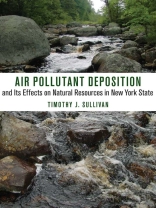Ecosystem effects from air pollution in the Adirondacks, Catskills, and elsewhere in New York have been substantial. Efforts to characterize and quantify these impacts, and to examine more recent recovery, have focused largely on surface waters, soils, and forests. Lakes, streams, and soils have acidified. Estuaries have become more eutrophic. Nutrient cycles have been disrupted. Mercury has bioaccumulated to toxic levels. Plant species composition has changed. Some surface waters show signs of partial chemical recovery in response to emissions control programs, but available data suggest that soil chemistry may continue to deteriorate under expected future emissions and deposition. Resource managers, policymakers, and scientists now need to know the extent to which current and projected future emissions reductions will lead to ecosystem recovery.In this book, Timothy J. Sullivan provides a comprehensive synthesis of past, current, and potential future conditions regarding atmospheric sulfur, nitrogen oxides, ammonium, and mercury deposition; surface water chemistry; soil chemistry; forests; and aquatic biota in New York, providing much needed information to help set emissions reduction goals, evaluate incremental improvements, conduct cost/benefit analyses, and prioritize research needs. He draws upon a wealth of research conducted over the past thirty years that has categorized, quantified, and advanced understanding of ecosystem processes related to atmospheric deposition of strong acids, nutrients, and mercury and associated ecosystem effects. An important component of this volume is the new interest in the management and mitigation of ecosystem damage from air pollution stress, which builds on the ‚critical loads‘ approach pioneered in Europe and now gaining interest in the United States.This book will inform scientists, resource managers, and policy analysts regarding the state of scientific knowledge on these complex topics and their policy relevance and will help to guide public policy assessment work in New York, the Northeast, and nationally.
Inhaltsverzeichnis
1 Background and Purpose1.1.Atmospheric Deposition in New York1.2. Air Quality Management1.2.1. Clean Air Act1.2.2. Regional Haze Rule1.2.3. Federal Water Pollution Control Act1.2.4. Other Legislation1.3. Ecosystem Functions and Services1.4. Goals and Objectives2. Resource Sensitivity to Atmospheric Deposition2.1. Geology2.2. Soils2.3. Forest Vegetation2.4. Hydrology and Hydrodynamics2.5. Wetlands2.6. Surface Water2.6.1. Streams and Lakes2.6.1.1. Acid-Base Chemistry2.6.1.2. Nutrients2.6.2. Estuaries and Near-Coastal Marine Waters3. Principal Stressors3.1. Sulfur, Nitrogen, and Mercury Emissions and Deposition3.1.1. Sulfur Emissions and Deposition3.1.1.1. Sulfur Emissions into the Atmosphere3.1.1.2. Sulfur Deposition3.1.2. Nitrogen Oxide and Ammonia Emissions and Deposition3.1.2.1. Nitrogen Emissions into the Atmosphere3.1.2.2. Nitrogen Deposition and Other Watershed N Sources3.1.3. Mercury Emissions and Deposition3.1.3.1. Mercury Emissions into the Atmosphere3.1.3.2. Mercury Deposition3.2. Watershed Disturbance3.2.1. Timber Harvest and Fire3.2.2. Land Use Change3.2.3. Invasive Species3.2.4. Other Disturbances3.2.5. Multiple Stress Response3.3. Mercury Bioaccumulation and Biomagnification3.4. Climate Change3.4.1. Influence of Soil Freezing on N Cycling3.4.2. Extreme Events4. Chemical Effects of Atmospheric Deposition4.1. Sulfur4.1.1. Upland Sulfur Cycling Processes4.1.2. Wetland Sulfur Cycling Processes4.1.3. Surface Water Sulfur Cycling Processes4.2. Nitrogen4.2.1. Upland Nitrogen Cycling Processes4.2.2. Wetland Nitrogen Cycling Processes4.2.3. Fresh Surface Water Nitrogen Cycling Processes4.2.4. Coastal Nitrogen Cycling Processes4.2.5. Nitrogen Saturation4.3. Dissolved Organic Carbon4.3.1. Upland Processes4.3.2. Wetland Processes4.3.3. Surface Water Processes4.4. Base Cations and Aluminum4.4.1. Upland Processes4.4.2. Wetland and Surface Water Processes4.5. Acid-Base Interactions4.5.1. Soil-Water Interactions4.5.2. Upland Processes4.5.3. Base Cation Depletion4.5.4. Wetland and Surface Water Processes4.5.4.1. Chronic Acidification Processes4.5.4.2. Episodic Acidification Processes4.6. Nutrient Interactions4.6.1. Terrestrial Effects4.6.2. Wetland Effects4.6.3… Surface Water Effects4.6.3.1. High Elevation Lakes4.6.3.2. Great Lakes4.6.3.3. Coastal Waters4.7. Mercury Interactions4.7.1… Upland Processes4.7.2… Wetland Processes4.7.3… Surface Water Processes5. Biotic Effects of Atmospheric Deposition5.1. Terrestrial Resource Response to Acidification, Eutrophication and Mercury Input5.1.1… Red Spruce Response to Acidification5.1.2… Sugar Maple Response to Acidification5.1.3… Vegetation Response to Nitrogen Supply5.1.4… Avian Response to Acidification5.1.5… Mercury Methylation5.1.6… Effects of Mercury on Humans5.2. Effects on the Biology of Freshwater Ecosystems5.2.1… Phytoplankton5.2.2… Zooplankton5.2.3… Benthic Macroinvertebrates5.2.4… Fish5.2.4.1. Effects of Acidification on Fish5.2.4.2. Effects of Mercury on Fish5.2.4.3. Effects of Environmental Factors on Mercury Bioaccumulation in Fish5.2.5… Fish-Eating Birds and Mammals5.2.5.1. Fish-Eating Birds5.2.5.2. Fish-Eating Mammals5.2.6… Other Life Forms5.2.7… Community Metrics5.2.7.1. Taxonomic Richness5.2.7.2. Indices of Biotic Integrity5.3. Effects on Coastal Aquatic Biota5.3.1… Phytoplankton in Coastal Waters5.3.2… Submerged Aquatic Vegetation5.3.3… Shellfish and Fish Chapter 6. Historical Patterns of Effects6.1. Paleoecological Studies6.2. Watershed Model Hindcast Studies6.3. Recent Trends in Monitoring Data6.3.1… Wet and Dry Deposition6.3.2… Soils6.3.3… Surface Waters 6.3.3.1. Chemistry6.3.3.2. Biology Chapter 7. Extrapolation of Site-Specific Data to the Broader Region7.1. Methods of Regionalization7.2. Regionalization of Survey Data 7.3. Regionalization of Long-Term Monitoring Data Chapter 8. Projected Future Responses of Sensitive Resources to Reductions in Acidic Atmospheric Deposition8.1. Modeling Approaches8.1.1… MAGIC8.1.2… Pn ET-BGC8.1.3… SPARROW8.1.4… WATERSN8.1.5… ASSETS8.2. Projections Based on Existing and Future Emissions Controls Chapter 9. Critical Load9.1. Approaches9.2. Critical- and Target-Load Calculations9.3. Utility to Policy Makers9.4. Linkages to Biological Response Chapter 10. Climate Linkages10.1. Temperature10.2. Water Quantity and Quality Chapter 11. Linkages with Ecosystem Services11.1. Forest and Freshwater Aquatic Resources11.2. Coastal Resources Chapter 12. Active Intervention Chapter 13. Summary and Important Data Gaps and Recommendations












